Sick of having your sausages floating around in ice slushy water at the bottom of the esky?
Me too!
That’s why when we started camping one of the first things we bought was a 12 volt camping fridge.
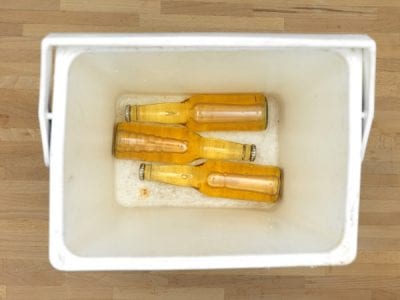
You have a few options, but like everything in life, there are pros and cons to all of them.
Using your Starting Battery
Note: We do not recommend this type of setup.
Your Starting or Cranking Battery is generally located under the bonnet of your car, its sole purpose in life is to start your car. Starting Batteries are great for starting a car, as these batteries deliver a big burst of energy for only a few seconds.
You can run a cable from the starting battery to your 12 volt camping fridge and voilà the beers will get cold. However, starting batteries are not designed for powering a fridge where a low output is required for an extended period.
Also, you will need to install an extra cigarette socket or Anderson plug in your car. The cigarette socket that comes standard from the factory will only provide power when the car is running. So when you are stopped overnight and the car is off it won’t power the fridge. This means you will need to install an extra outlet that is set up to power the fridge when the car is turned off.
Low Battery Cut-Out Feature
Most 12 volt camping fridges these days have a low battery cut-out feature. Basically, the fridge will turn off when the battery reaches a set voltage. The theory is if you go to bed with your fridge running from your starting battery, the low battery cut-out will turn the fridge off when the battery gets to a certain voltage. This will ensure there is sufficient power in your starting battery to start the vehicle the next day.
Let’s just say, with the low battery cut-out you are skating on thin ice. If a light is left on in the car or you leave the door open for a few minutes you run the risk (and I speak from experience) that the car won’t start when you are in the middle of NOWHERE.
Pro’s
- Lowest Setup Cost
- Quick to install
Con’s
- Run risk of flattening start battery and car not starting
- If you flatten the start battery multiple times it will need replacing
- Will only power the fridge for a short period of time (usually less than 24hrs)
Dual Battery System
The best way to ensure your fridge will stay cold overnight and your car will start in the morning is with a Dual Battery System.
As the name
We generally recommend a dedicated deep cycle battery. Deep Cycle batteries are designed to consistently deliver small amounts of power, for much longer and to allow a much deeper discharge, reducing damage.
You can read about the different types of deep cycle batteries here
The type of dual battery system you choose will depend on numerous things.
- How much you want to spend
- Where you are installing it (Under Bonnet, in
cab or intray or in caravan/camper trailer) - How long you need to run the fridge
- How long you can go in between charges
Like everything in life, there are lots of options.
We’ve created a quick summary of common Dual Battery System options below:
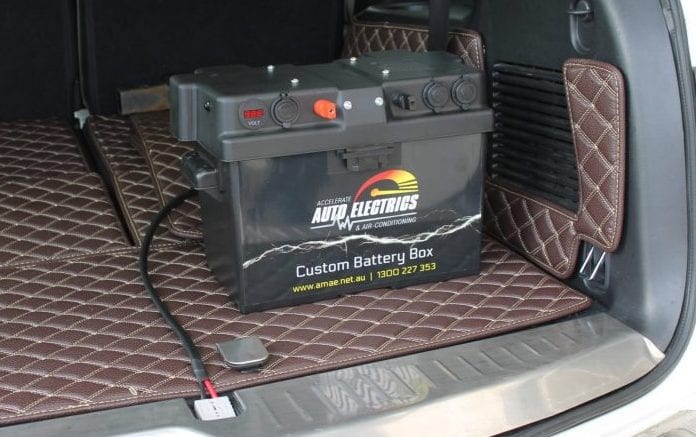
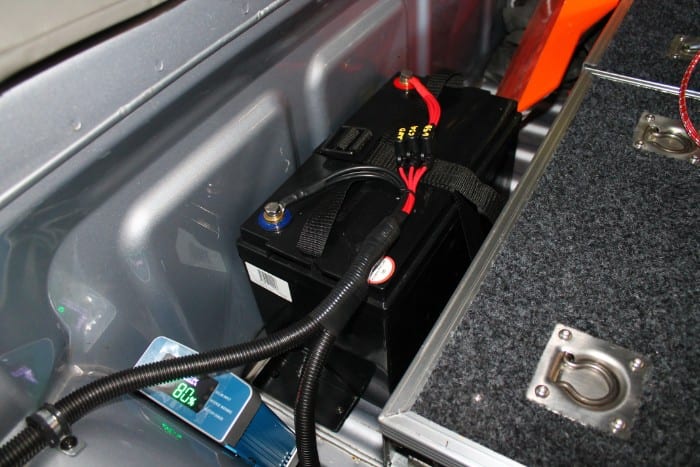
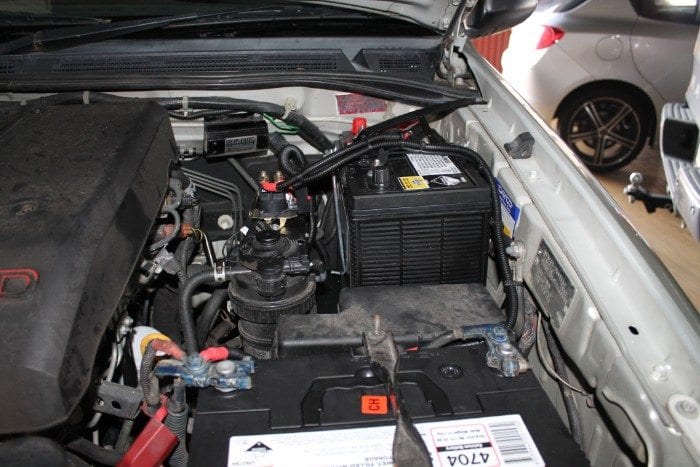
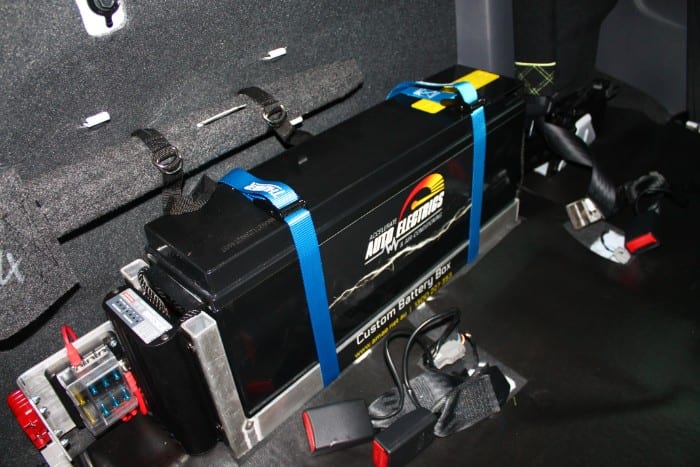
Keeping your dual battery charged
If like us, you have decided the dual battery is the best option to power your 12 volt camping fridge, you will need to look at ways to charge the battery.
As we mentioned above, you can use your car’s starting battery to charge your auxiliary battery with quite a simple set up. However, if you want to go camping for longer than 2-3 days and driving around waiting for your auxiliary battery to charge doesn’t seem like a nice way to spend your relaxing trip, here are some other options for charging.
- Solar
- Generator
Solar
In South East Queensland the sun shines on average 2,884 hours a year. So it makes sense to harness this free energy source to power your dual battery and fridge. There are lots of types of solar panels available to suit your needs as well as multiple sizes to ensure you have enough power to keep your fridge and gadgets charged.
Our portable solar panel kits are the most simple, when your battery is running low you can easily put the solar panel out in the sun, plug it into the auxiliary battery and it will easily recharge your battery in a matter of hours. As the sun is shining you will be self-sufficient.
Pros
- Recharges battery when not driving
- Free Power (after initial outlay)
- Maintenance Free
Cons
- Weather dependent
- If portable – Security
Generator
Pros
- For a cheaper initial outlay, the generator will make more power than solar
Cons
- Requires Maintenance
- Requires Fuel
- Noisey & Smelly
- Some camping places will not allow them

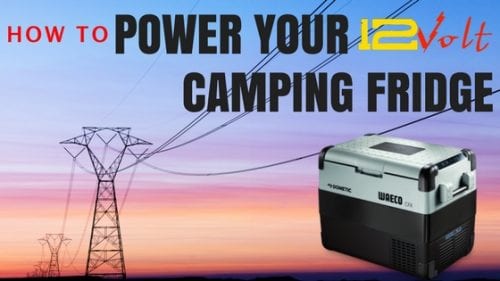
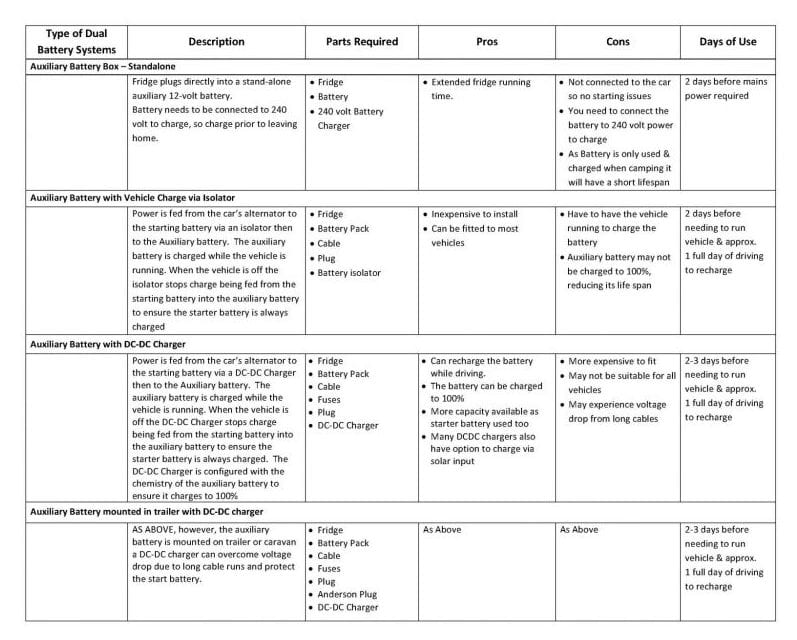

Hi ,have a camper trailer (just purchased) it has a fridge mate that worked while I was driving it home and then it stopped.i plugged to the mains and its green light has come on but not the fridge ,I have a spare engel and plugged it into a power source and that works well.it has both a project DC/SOLAR Bat Charger 25amp 3 switchmode .And a CTEC MXS7.0and AGM and Wet batt. a light ??in red shows 11.6 and this changes ,its been in 240 wall for 2 days and the fridge is staying on the green.
cheers Paul
hello I’m trying to understand the best way to power my 12v donmende car fridge off of a 100ah lead acid deep cycle battery that is recharged by a 100w solar panel. I’m unsure if I have enough power and also unsure of the best way of hooking the fridge to that power supply. Any advice would be helpful thanks!
Usually, with a fridge we recommend a minimum of 120w solar, but it does depend on the power draw of the fridge. For more specific recommendations, we’d need more details of the system, so feel free to get touch with us via phone or email if you have any more questions.
Hi,
I am building a work trailer which has a 40L Waico on it and the trailer also has a 7Kva generator on it. Because I frequently turn the gen set on and off during the day, I want to install a 12 volt battery on the trailer and connect it to the generators 12 volt plug and then run wires from the battery to a 12 volt plug so I can plug the fridge into it. That way, the fridge will not stop running each time I turn the generator off, as it is powered by the battery, which in turn gets charged each time I turn the generator on.
My question is…… When I put my voltage meter on the battery when the generator is running, it’s showing 18 volts. Will that damage the fridge?
Thanks,
Greg
Hi Greg, 18v is quite high and this can cause damage to mainly your battery and possibly the fridge connected to that. We would recommend for correct charging purposes of the battery to use either a DCDC charger wired for vehicle charge or 240v battery charger plugged into the generator to ensure it does not overcharge and damage your battery.
Hi i am looking at powering a car fridge . I have a 2016 pajero sport with a variable alternator do i have to run a dc to dc charger. I am thinking of a portable battery as the option? I believe this would be the more costr effective option insteas of a dual battery system fitted to the car is that correct
Hi Lloyd, yes a portable battery box is the most cost-effective option in most cases. If you look for one with a built-in DC-DC charger, that would probably be the ideal solution for you. We have a couple of options available on our online store (including our custom made boxes) if you want to check them out >> https://www.4wdcaravanelectrics.com.au/
I have a camper with 2 x 80AH batteries (12v parallel connection) that are currently charged by either a fixed 240v charger or solar panels through a 20A solar controller. I am looking at putting a dual battery system in my vehicle using a DCDC charger which would mean that when I am camped I have the camper batteries and (after sufficient driving) a fully charged aux battery in the vehicle. When camping, I would like to be able to utilise the power from the car aux battery in the camper to increase total AH. ie in effect, have 3 x batteries. Is it possible/viable to connect the car aux battery to the camper using an anderson plug or similar that can be readily disconnected? thanks for any advice/suggestions.
Yes, it is possible to do it. It is not really ideal as the batteries will be ‘out of balance’ especially if they are different chemistries. A better idea if you want to increase your camper capacity would be to replace the 80 amp batteries to 120Amp batteries or look at lithium or lead crystal.
Hi, I have a dual battery solar paneled 4wd, I was just wondering if I can run ‘two’ fridges of the one battery. Thanks
Hi Dan, in our experience for your battery system to be reliable you should have 1 battery per fridge and a good amount of solar.
I think this is oone of the ost important information for me.
And i am glad reading your article. But wanna remark on some general things, Thhe web
site style is ideal, the articles is really excellent :
D. Goodd job, cheers
Thanks, glad you found the article helpful. Be sure to check out some of our other blog posts for more useful tips.
Hello, I recently purchased a refurbished Senno Scotty camper, the wiring has been updated but only for serviced lots. We like the more private unserviced camping spots and I’d like to be able to run my refrigerator on DC, I have new AGM battery, a solar panel and the seller supplied a new RV inverter. The problem is I’m basically clueless on how to wire a simple system. My goal is a basic system to run my fridge and if possible, a fan from one or two batteries and to be able to charge the batteries with solar if they run out. We never camp for more than a week at a time.
Any advice you folks have would be greatly appreciated.
I have a camper with a 3 way fridge and dual batteries with solar power. I want to fit an Anderson plug on the car but I need to know something:
The Anderson on the camper has always 12V coming from the inside battery and it is connected also to the fridge in 12V because it works in 12V without external hook up.
If I connect the camper and the car, will it send energy from the car to the fridge and the battery in the camper reversing the flow of 12V?
Thanks
Hi Carlo, If there is no isolator in the system at all then the flow of power will always be from higher to lower voltage. In simple terms, if the car is running then the flow will be from the car to the camper because the alternator is charging so the vehicle voltage will be higher. Then once the car is off the flow of current will be from the highest point, i.e. a fully charged car battery to the camper battery running the fridge as the drain from the fridge will pull down the camper battery. If you had solar on your camper and the headlights switched on in your car then the flow would be from the camper to the car as the headlights would be pulling the circuit down. This is why you would always add an isolator of some sort to stop the vehicle battery discharging so the car won’t start. There are many products available to control the direction of flow to a favourable one. I hope this helps. If you have any further questions, please feel free to give us a call or send us an email. Thanks.
Dear Sir/Madam, is there a way to wire a car, (with or without a dual battery system), where 12V items like a fridge and an inverter powered item such as a small medical device can be run overnight and if the battery charges fall below a programmed point, the car will automatically startup to recharge the batteries?
Hi Johann, Yes, we could certainly develop this system. How complex the system would need to be would depend on the vehicle. There are other simpler ways we could possibly suggest like having a larger battery bank or running a 2nd slave battery that would only be utilised if needed. If you would like to discuss your options feel free to give us a call on 07 5479 6652 or email us at info@amae.net.au. Thanks.